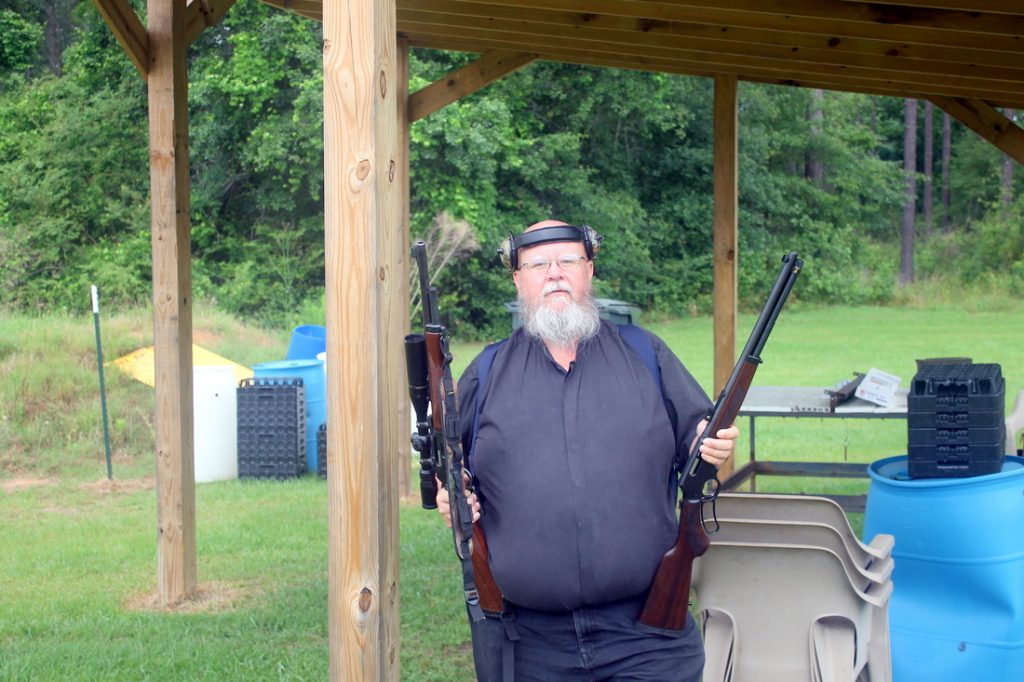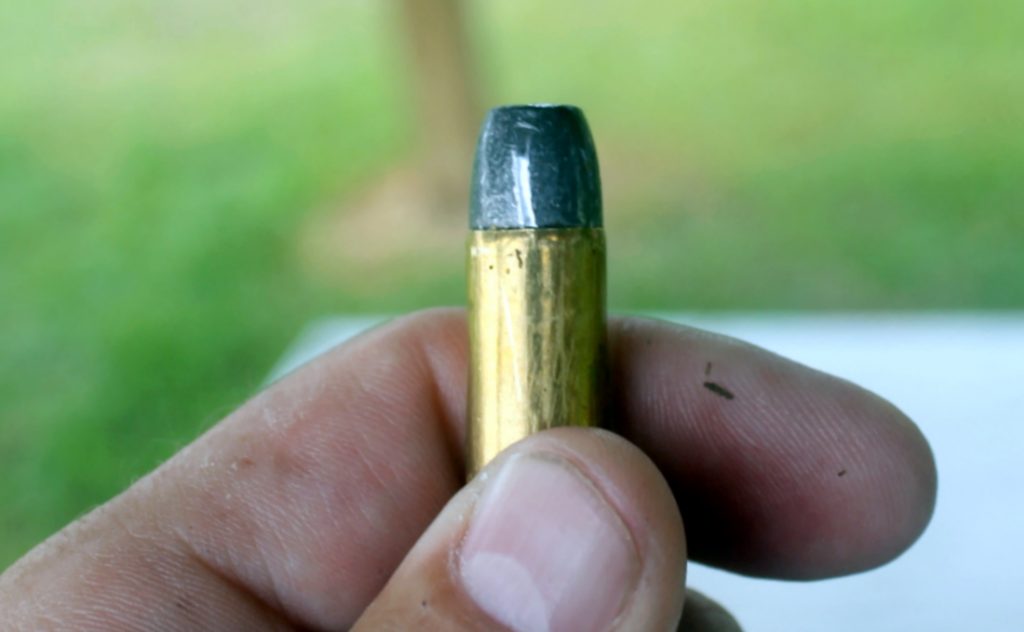Let’s take a deep look at the two rifles
Fall 2025
By Ben Baker
Keep this in mind, the venerated .45-70 is the only rifle rated for the Tyrannosaurus Rex, as evidenced by the Jurassic Park movies.

The author with the two rifles at the range.
HENRY .45-70
Barrel – 18.43″, round blued steel
Twist – 1:20
Overall length – 37.5″
Weight – 7.08 lbs.
Rear sight – Fully adjustable semi-buckhorn with a diamond insert
Front sight – Brass bead
Safety – Transfer bar
Pull – 14 inches
MARLIN .45-70
Barrel – 18.5, round blued steel
Twist – 1:20
Length – 37″
Weight – 7 pounds
Rear sight – Folding adjustable semi-buckhorn
Front sight – Brass bead with “Wide-Scan” hood
Safety – Push button in the receiver, half-cock on the hammer, transfer bar. After-market blank safety buttons are available so this feature can be removed.
Pull – 13 3/8″
Note – The Marlin used in this comparison is JM Marlin 1895G. It comes with a heavier barrel than the Henry and so weighs a bit more. The 1895G barrel is also ported, which is not offered in the current Marlin line. The Marlin was also scoped.
The receiver in both is also tapped for a rail. If you mount a scope, be aware the screw holes go all the way through the receiver. Overset the screws and you lock the bolt down. Overset by just a hair and you can work the bolt, but the screws can scrape the top of the bolt. A thumb bar can be added to either rifle’s exposed hammer to make cocking easier.
When pulled slowly, the hammer’s engagement click is identical in both rifles.
.45-70 AMMO
Ammo used in this test was factory 300-grain cast ball in Starline brass loaded light. Remington factory loads in 300-grain Semi JHP and 405-grain soft point and 300-grain lead HP hand loaded hot in assorted brass. Ammo was shot in that order. On the range, the Henry had a failure-to-feed with some of the Remington loads, even when loading a round by hand into the breech. The bolt would not completely close. Everything else worked perfectly. The Marlin digested everything run through it.
LOADING
The rifles are both tube-magazine fed. The Marlin .45-70 has a loading gate in the receiver. The Henry .45-70 has a removable rod and loading port in the tube near the muzzle.
The Marlin loads faster. Just push a bullet into the gate and then through until it seats. At the same time, the Marlin has a very stiff load gate spring. Loading can be done with one hand, but is easier with two. Push the round down with one hand to move the gate aside and push the round in with the other hand. The Marlin can also shave a tiny bit of lead off the projectile as it goes in. While this is not enough to affect bullet performance, it is a tiny amount of lead shaving that could get into the works. Lighter after-market springs are available.
The Marlin also loads easier under tight quarters. Just push a round in. Lay the gun on the seat of a vehicle, barrel pointing down, and load. When loading, except for reaching for rounds, your hands can stay on the receiver. Less motion is needed to load the Marlin, something deer hunters might appreciate.
With enough space, the Henry loads easily. Space is needed because of the magazine push rod. You do not have to remove the rod all the way because of the port in the tube. Inside a vehicle, this means moving the gun around, finding space to pull the rod and so forth. On a deer stand this is less of an issue. On horseback, if the horse is still, also less of a problem. Loading is definitely a two-hand operation. One hand to hold the gun and rod and one to feed rounds.
The Henry tube has a reinforced ring at the end that goes to the very end. This protects the thin metal of the tube. The rod locks firmly into place. The push rod will not shave lead off any of the loaded rounds. The rod has a heavily checkered cap. Even with winter gloves, removing the cap is easy enough.

Loading while wearing winter gear definitely separates the two. The Marlin gate will trap glove fingertips. Removing the glove is not just a yank it free move. The glove could tear. Bits of glove inside the action is a recipe for disaster. A glove tip could wedge in much tighter. Removing a stuck glove is a two-hand operation, one hand to push the gate down while the second hand pulls the glove free. With the tube and generous cut-out, loading the Henry is easy if you can pick up the ammo wearing gloves.
You can replace the Marlin with a big loop lever, a simple process that you can easily do at home. If you want to wrap the lever with leather, a bigger loop is advised.
According to the company, the Henry is a four-round rifle. The magazine tube effectively holds five rounds. That does not put one in the chamber. The Henry has no external or half-cock safeties so the company advises to not put one down the pipe until the shooter is ready to fire. Putting another round down the mag tube with one in the chamber is not advised. The tube may appear to hold six rounds. It doesn’t. Pushing the rod home and locking it down forces the first round out of the mag AND partly engages the lever. That round must be chambered or removed for the lever to close.
The Marlin holds four in the tube and one in the breech.
SHOOTERS
The range crew was myself, law enforcement firearms instructor Richard Purvis, retired Chief of Police Bill Ryder and firearms expert, trainer and former police chief Joseph Saxon.
SHOULDER
Both rifles went from carry to the shoulder equally well for all four shooters. Getting a sight picture was easier with the Henry because the Marlin was equipped with a scope. If both had iron sights or scopes, target acquisition is the same.
If your rifle is a brush gun for tight quarters and fast reaction times, do not use a scope. If you plan to use it from a stand and have time to line up a shot, shooter’s choice. I scoped the Marlin because his eyesight is not what it used to be.
In Canada, I shot a huge sow bear with an 1895G topped with a red dot. She went about 40 yards, the 405-grain JHP tearing out part of her heart and leaving a huge blood trail to follow. I expect the exact same performance from the Henry.
TRIGGER & LEVER
The Henry trigger is tight and snaps cleanly. The Marlin has a lot of slop in the trigger; it will flop back and forth about a quarter-inch with the hammer drawn. The Marlin trigger is also heavier and does not pull as clean.
Both have the standard lever-action lock feature. Unless the lever is tight against the stock and tang, neither will fire.
The Marlin has a safety. A lot of shooters remove this with an after-market solid pin. I prefer the safety.
At the range, the Henry action was stiffer than the Marlin. Shooters attributed this to the Henry being NIB and the Marlin used. With time, the action on the Henry should ease up.
The Henry is a semi-pistol stock and so the lever is curved. The Marlin has a straight or English stock and squared lever.
STOCK
Both come with American black walnut furniture and are tapped for slings. Both have a rubber recoil pad. After market synthetic furniture is available. Another 1895 I have has skeleton furniture for a tactical look.
ON THE RANGE
Of the four shooters, only Saxon said he could not tell a significant difference in recoil between the two guns ammo-to-ammo. He did notice a difference between the three rounds. The other three noticed a difference, especially with the hot handholds. The Marlin was appreciably lighter, they said. This is likely attributable to the increased weight of the Marlin and the ported barrel. Standing a few feet away to shoot video, the Marlin’s report was also a bit louder than the Henry.”It’s essentially the same rifle,” Purvis said. “But the Marlin (with hot ammo), it doesn’t hurt.”
Ryder had a different opinion on the hot loads. “It’s not that bad,” he said. “I liked all three loads. With the first (the light lead ball) it was like shooting a .22.”
To me, the hot loads definitely thumped more in both rifles, but the Marlin was tamer. Slide another decent recoil reducer on either gun and even the hot loads behave.
Accuracy was acceptable for in both rifles and showed little difference. This is a .45-70 carbine. If sub-MOA groups at 100 yards is a requirement, this is not the gun for you. If putting five rounds into the chest of a deer at 100 yards is what you want, either gun will do that every time in the hands of a good shooter.
OPINIONS
Two of the four shooters, Saxon and Ryder, preferred the Henry because of the more traditional look, i.e. no external safety and no scope. Purvis was equally happy with either rifle. I like the external safety and half-cock measure on the Marlin. If shooting iron sights, I preferred the Henry because it was more easily adjustable.
WARRANTY
Henry comes with a lifetime warranty. Ruger now owns Marlin and any of the pre-Remington guns have no warranty. Ruger does not list any warranty information about its products.
THE .45-70

The full name for this cartridge is .45-70 Government. It is also known as the 45-70 (11.6x53mmR), 45-70 Springfield, and .45-21⁄10” Sharps.
It started life as a black-powder load. Originally, it was a 45-caliber bullet atop 70 grains of black powder. And this creates some issues for modern shooters and modern ammo. Old Springfield trapdoor rifles are meant for black powder. These old military rifles are still around and a great bargain, but you MUST BE CAREFUL. These old rifles will not handle high-pressure modern powder loads.
If you have a modern Henry or a modern Marlin, you can shoot black powder to heavy & hot smokeless loads. Before you shoot ammo like Buffalo Bore, call the manufacturer and ask first. I verified with Marlin and Henry before shooting hot loaded JHPs. Reloading manuals include black-powder loads, low-power loads and really heavy hitting loads.
A while back I bought a bunch of 95 grain aluminum pills for this rifle. Why? Because kids can handle the recoil and it will take out a deer at South Georgia shooting distances. Typical weights are 300 grain to 500 grain with some even heavier bullets occasionally available. If you cast your own bullets, you can make whatever weight you want.
With 500-grain hardcast projectiles, I would hunt any critter walking the planet today, including elephant. The hardcast has immense penetration. Being a lever action, I have several more shots ready to go. It’s not as fast as a double rifle, but is more reliable with these big rounds than an automatic and it is much faster than a bolt action.
The .45-70 was created the year after the Civil War, making one of the oldest cartridge cases still around.
Ben Baker is the Executive Editor of B&H Publications, including the Wiregrass Farmer Newspaper in Ashburn. He also is a member of the Georgia Outdoor Writers Association. Ben can be contacted at redneckgenius@gmail.com.